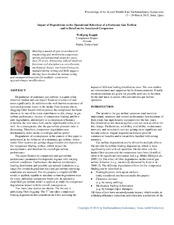| dc.contributor | Middle Eastern Turbomachinery Symposium (2nd : 2013) | |
| dc.creator | Kappis, Wolfgang | |
| dc.date.accessioned | 2018-10-12T19:39:07Z | |
| dc.date.available | 2018-10-12T19:39:07Z | |
| dc.date.issued | 2013 | |
| dc.identifier.uri | https://hdl.handle.net/1969.1/172615 | |
| dc.description | Lecture | en |
| dc.description.abstract | Degradation of stationary gas turbines is a quite often observed burden and can impact financial revenues of end-users significantly. In addition to the well-known occurrence of increased pressure losses in the intake filter systems due to clogging (filter loaded with deposits), the compressor has been shown to be one of the main contributors to this change in gas turbine performance. In case of compressor blading and flow path degradation, additionally to a compressor efficiency reduction, the inlet mass flow can be significantly reduced as well. As a consequence also the gas turbine pressure ratio is decreasing. Therefore, compressor degradation acts detrimentally twice on the overall gas turbine power.
Degradation of a compressor in the context of this paper is understood as the behavior of a stationary gas turbine, where intake filter systems are getting clogged and/or dirt deposits on the compressor blading surface, which impact the aerodynamics, and therefore the overall gas turbine performance.
The paper focuses on compressor and gas turbine performance parameters for degraded engines with varying ambient conditions. Furthermore the internal aerodynamic loading distribution and possible operational limitations (e.g. surge) for certain degradation rates and gas turbine operating conditions are assessed. For this purpose a simplified CFD model is applied, capable to simulate certain degradation rates for every individual compressor blade row. In addition a simplified gas turbine model is applied, to study the compressor degradation impact with its overall consequences.
Two basic case studies are shown. The 1st one is addressing filter clogging. The 2nd one takes compressor blading degradation into consideration while assessing the impact of different fouling distribution rates. The case studies are substantiated and supported by field measurements. Finally recommendations are given for possible activities to be taken by the end-users to ensure efficient and safe gas turbine operation. | en |
| dc.format.medium | Electronic | en |
| dc.format.mimetype | application/pdf | |
| dc.language.iso | en | |
| dc.publisher | Turbomachinery Laboratory, Texas A&M Engineering Experiment Station | |
| dc.relation.ispartof | Middle East Turbomachinery Symposia. 2013 Proceedings. | en |
| dc.subject.lcsh | Turbomachines | en |
| dc.title | Impact of Degradation on the Operational Behaviour of a Stationary Gas Turbine
and in Detail on the Associated Compressor | en |
| dc.type.genre | conference publication | en |
| dc.type.material | Text | en |
| dc.format.digitalOrigin | born digital | en |


